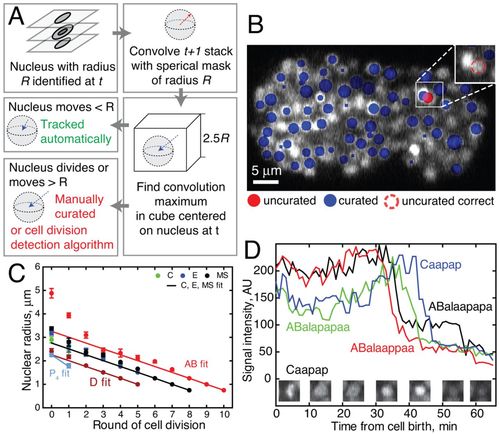Fig. 2
- ID
- ZDB-FIG-121206-5
- Publication
- Giurumescu et al., 2012 - Quantitative semi-automated analysis of morphogenesis with single-cell resolution in complex embryos
- Other Figures
- All Figure Page
- Back to All Figure Page
|
Automated nuclear tracking using local search. (A) Overview of the tracking algorithm in NucleiTracker4D. The tracking component searches the neighboring space of each nucleus identified at t for new convolution signal maxima. Only nuclei not satisfying the automatic tracking condition (e.g. displacement≥R) are prompted for manual curation. (B) An example of a tracking error requiring manual curation. Here, an AB nucleus was mis-tracked towards one of its MS neighbors owing to differing brightness among sublineages. The user corrected position is marked with a dashed red line. (C) Variation in nuclear radii in the major embryonic sublineages. The linear fit is used as a model of nuclear radius in NucleiTracker4D. For early cells (AB, C, E, MS) n≥5 (data from five embryos with a nucleus present in at least one time point); for all other cells, 16≥n≤32, from two embryos with nuclei present for at least two time points. Where more than eight descendants (after third round of division) are present at one time point, cells quantified were picked at random. Error bars represent s.e.m. (D) Apoptotic cells undergo characteristic changes in HIS-72::GFP fluorescence; see supplementary material Movie 3. Nuclei of dying cells are assigned a radius according to the model until signal intensity decreases sharply corresponding to DNA condensation (~25 minutes after cell birth). At this point the dying cell nuclear radius is plotted as a minimal radius (0.5 μm). After another ~20 minutes, the HIS-72::GFP signal decreases as the cell is engulfed. |

